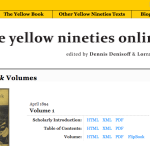By Karen Bourrier
For the past few semesters, inspired by Joshua Eyeler’s post on “Teaching with Twitter; or Adventures in Student Engagement,” I’ve had a social media participation component in my classroom. I’ve now used Twitter at all levels, from the freshman writing seminar to the graduate classroom. It’s worked well in all of these settings, but I think I’ve had the most success at the 400-level, with third and fourth year university students studying Victorian literature. The reason for this success, I think, is two-fold. One, third and fourth year students are sophisticated and engaged enough with literature that they get the possibilities of the medium immediately: they use Twitter to respond in real-time to plot developments (there’s a madwoman in the attic!), to comment on versions of Victorian texts that have entered the cultural mainstream (Please sir, can I have some more?), and of course, to raise questions for class discussion. The second reason for this success, I think, is that third and fourth year university students are not yet too worried about formulating identities as professional literary critics on the web, which leaves room for a freewheeling discussion.
What I enjoy most about using Twitter in the classroom is finding out more about my students and what they think about the works we’re reading early on in the semester. I learn about their sense of humour and the many ways they encounter Victorian literature in popular culture. I also find out who the really smart but shy students are early on, since they will Tweet, but not necessarily put their hands up in a class of 40. (Incidentally, our class Twitter stream is also a pretty good gauge of who is keeping up with the reading!) In my class of 40, which is something in between a seminar and a lecture, social media fosters some of the bonds that would come from a smaller classroom. I also assign a Storify, where a student archives the Tweets from one day’s class, in lieu of a seminar presentation. This serves as a record and a study guide for the final exam.
The odd student won’t complete the Twitter assignment. That’s okay, it’s only worth 5% and won’t kill their grade. When I started this assignment, I thought more students would want to remain anonymous, and though I have the option written into the assignment, I have yet to have a single student take me up on it. If you are interested in seeing what we’ve done with Twitter, you can take a look at our Storify archives for Early Victorian Literature here, and Late Victorian Literature here.
I’ll post my assignment below. In the meantime, I’d love to know, have you used social media in the classroom? Was it successful?
Twitter Assignment for ENGL 449
The social networking site Twitter has gained tremendous currency over the past few years as a place where academics and professionals can learn and share ideas. To spark our class conversations and keep them going throughout the week, everyone in the class will tweet a minimum of six times a week (three tweets per class). We will use the hashtag #ENG449 to keep track of the tweets. The only guidelines are that your tweets must be respectful and relevant to the class. Your tweets could include 1) a question or an observation about the reading 2) a quotation from the reading 3) a response to a tweet 4) a link to a relevant resource (scholarly article, film adaptation etc.). Each student will also be responsible for creating a Storify narrative of the tweets from one day’s class, due before the next class, which I will post to our course website, and which everyone can draw on to generate ideas for papers and to study for the final exam.
Because Twitter is public, I encourage you to put your best, most professional foot forward in your tweets. You can follow your classmates and me @kbourrier, but I also encourage you to follow people in your future career path. It will be easiest for everyone in the class to link Twitter identities with classroom identities if you are comfortable using your name and a picture of yourself as part of your Twitter handle, but this is not required. If you choose to be anonymous, let me know what your Twitter handle is so that I can give you credit for participation. Students who complete the Storify assignment, the minimum number of tweets (78) and whose tweets show engagement with the texts can expect to receive an A- (4/5), with an A+ (5/5) being reserved for exceptional engagement.
Adapted from Josh Eyler, Rice University: https://josheyler.wordpress.com/2013/04/18/teaching-with-twitter-or-adventures-in-student-engagement/



